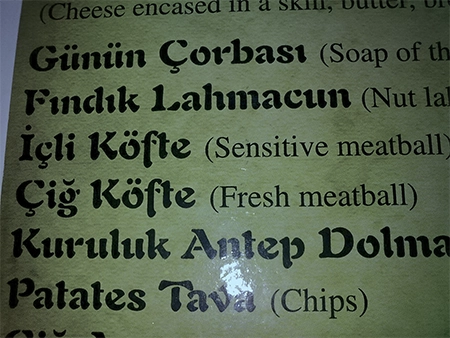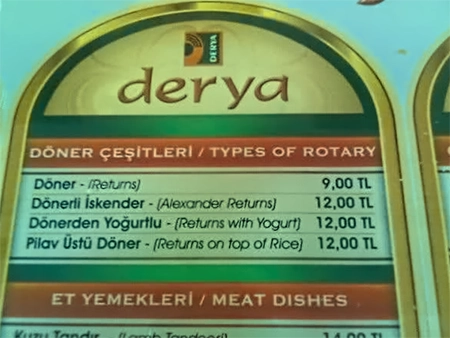Challenges and Humor in Culinary Translations
Translating culinary content can often lead to unexpected challenges and humorous results, particularly when the process is automated or handled without the necessary cultural and linguistic insight. In Culinary and Food Translation, the importance of accuracy becomes evident when minor errors translate into amusing or confusing menu items. Many restaurants, for instance, use tools like Google Translate to convert their menu items from Turkish into English, resulting in some memorable mistranslations.

Translation Mishaps: Sensitive Meatballs
A notable example of such translation mishaps is seen with “içli köfte.” This Turkish dish, featuring spiced and flavoured mincemeat stuffed in a shell made of bulgur, is a delicacy that requires a nuanced description. However, when translated using Google Translate, “içli,” which means “with filling,” was amusingly rendered as “sensitive meatballs.”

Translation Mishaps: Alexander Returns
Similarly, the word “döner,” which in Turkish means to revolve or return, refers to the popular doner kebab in its noun form. Google Translate, failing to recognise the contextual usage, translated it based on its verb form, leading to descriptions that miss the mark in English. These examples underscore the need for human oversight in translation, especially when dealing with the nuanced language of food.
Such errors, while humorous, highlight the limitations of direct translation without context. So maybe stop searching for “culinary and food translation google” or “translate recipes online”.
The reliance on direct translation tools without a proper understanding of source and target languages can lead to these errors. While funny, they are practical examples of Culinary and Food Translation pitfalls. These errors are not just linguistic failures but can affect a restaurant’s ambience and the dining experience, potentially leading to misunderstandings or even deterrence of customers.
Moreover, culinary translation is not only about avoiding errors but also about capturing the essence of food and its cultural significance. The language used to describe food can evoke emotions and create anticipation. As noted by journalist and food blogger Dolce, in Britain, “food is the new sex,” where culinary presentations in media are so vivid and enticing that they become almost sensual experiences. This level of engagement shows how critical it is to translate the words and the culinary experience they represent.
Culinary Translation as a Cultural Reflection
Culinary translation does more than convert recipes from one language to another; it serves as a bridge between cultures, reflecting broader societal trends and the evolving relationship people have with food. In Culinary and Food Translation, understanding the cultural significance behind the dishes is as important as the linguistic conversion.
The deep connection between culture and cuisine can be seen in how nations express their identities through food. As noted by journalist and food blogger Dolce, food has become a new cultural currency in Britain, much like fashion or music once did. Today, people in London define themselves not just by their personal style or the music they listen to but by where they dine and whose recipes they cook at home. This cultural shift underscores the importance of culinary translations from Turkish into English, which must translate the recipe and the cultural essence that comes with it.
Translating culinary content also means adapting it to fit the local context while preserving its original flavour and intent. This often involves more than just finding the right words; it requires an understanding of the local culinary scene and the target audience’s preferences. For instance, when translating Turkish recipes for a British audience, it may be necessary to explain certain ingredients or cooking techniques common in Turkey but unfamiliar in the UK. This not only makes the recipes more accessible but also educates the reader about Turkish culinary traditions, fostering a greater appreciation and understanding.
Additionally, how food is discussed and celebrated in media and literature can influence culinary translation. The sensual portrayal of food in British culinary magazines, as described by Dolce, requires a translation approach that captures both the technical aspects of cooking and the emotive, almost intimate relationship people have with food. This dual focus ensures that the translations resonate with the audience on multiple levels—informative, engaging, and enticing.
Through thoughtful and culturally aware translations, we can convey not just the cooking method but also the joy and passion that come with culinary creations. By doing so, culinary translations help to expand culinary horizons, introduce new flavours, and deepen cross-cultural connections, making the global culinary landscape richer and more diverse.
